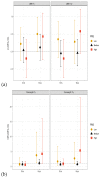Prenatal Vitamin D Levels Influence Growth and Body Composition until 11 Years in Boys
- PMID: 37432159
- PMCID: PMC10181475
- DOI: 10.3390/nu15092033
Prenatal Vitamin D Levels Influence Growth and Body Composition until 11 Years in Boys
Abstract
Background: Gestational vitamin D levels may influence offspring growth and modulate adipogenesis. Findings from prospective studies are inconsistent, and few have evaluated the persistence of these associations into late childhood.
Objective: To examine the association between prenatal vitamin D levels and growth and adiposity in late childhood.
Methods: We included 2027 mother-child pairs from the INMA birth cohort. 25-hydroxyvitamin D3 (vitamin D3) levels were measured in serum at 13 weeks of pregnancy. Sex- and age-specific body mass index z-scores were calculated at 7 and 11 years, overweight was defined as z-score ≥ 85th percentile, and body fat mass was measured at 11 years. Z-score body mass index (zBMI) trajectories from birth to 11 years were identified using latent class growth analysis.
Results: The prevalence of vitamin D3 deficiency (<20 ng/mL) was 17.5%, and around 40% of the children had overweight at both ages. Associations between vitamin D levels and outcomes differed by sex. In boys, maternal vitamin D3 deficient status was associated with higher zBMI, higher fat mass percentage, higher odds of being overweight, and with an increased risk of belonging to lower birth size followed by accelerated BMI gain trajectory. In girls no associations were observed.
Conclusion: Our results support a sex-specific programming effect of early pregnancy vitamin D3 levels on offspring body composition into late childhood observed in boys.
Keywords: body mass index; epidemiology; fat mass; growth; overweight; paediatrics; pregnancy; vitamin D.
Conflict of interest statement
All authors declare they have no conflict of interest to disclose.
Figures

References
-
- Moon R.J., Crozier S.R., Dennison E.M., Davies J.H., Robinson S.M., Inskip H.M., Godfrey K.M., Cooper C., Harvey N.C. Tracking of 25-HydroxyVitamin D Status during Pregnancy: The Importance of Vitamin D Supplementation. Am. J. Clin. Nutr. 2015;102:1081–1087. doi: 10.3945/ajcn.115.115295. - DOI - PMC - PubMed
MeSH terms
Substances
LinkOut - more resources
Full Text Sources
Medical

